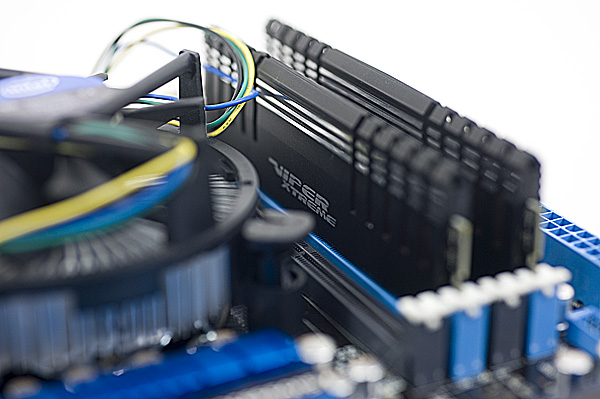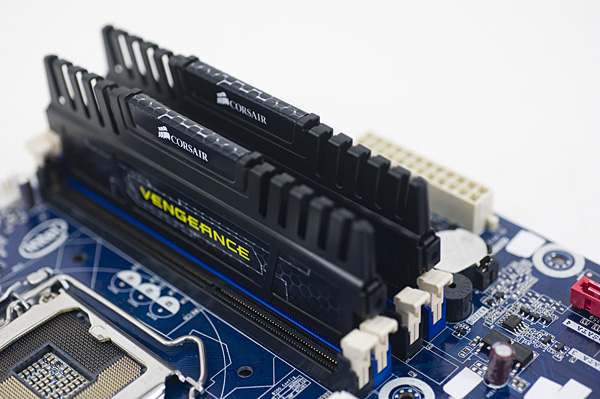The Sandy Bridge Review: Intel Core i7-2600K, i5-2500K and Core i3-2100 Tested
by Anand Lal Shimpi on January 3, 2011 12:01 AM ESTThe Test
To keep the review length manageable we're presenting a subset of our results here. For all benchmark results and even more comparisons be sure to use our performance comparison tool: Bench.
| Motherboard: |
ASUS P7H57DV- EVO (Intel H57) |
| Hard Disk: |
Intel X25-M SSD (80GB) Crucial RealSSD C300 |
| Memory: |
Corsair DDR3-1600 2x4GB (9-9-9-24) Corsair DDR3-1333 4x1GB (7-7-7-20) Corsair DDR3-1333 2x2GB (7-7-7-20) Patriot DDR3-1600 2x4GB (9-9-9-24) |
| Video Card: |
eVGA GeForce GTX 280 (Vista 64) ATI Radeon HD 5870 (Windows 7) MSI GeForce GTX 580 (Windows 7) |
| Video Drivers: |
AMD Catalyst 10.12 (Windows 7) NVIDIA ForceWare 293.09 (Windows 7) ATI Catalyst 9.12 (Windows 7) NVIDIA ForceWare 180.43 (Vista64) NVIDIA ForceWare 178.24 (Vista32) |
| Desktop Resolution: | 1920x1200 |
| OS: |
Windows Vista Ultimate 32-bit (for SYSMark) Windows Vista Ultimate 64-bit Windows 7 x64 |
Special thanks to Corsair for sending an 8GB Vengeance kit for this review:
As well as Patriot for sending an 8GB Viper Xtreme kit:

All of our brand new tests (Civilization V, Visual Studio) use 8GB memory configurations enabled by both Corsair and Patriot.











283 Comments
View All Comments
krazyderek - Monday, January 3, 2011 - link
putting the 3000 on the the 2600k and 2500k parts ALMOST made sense as an up-sell, but you can't even use their IGP when on a P series board when you're overclocking! If the Z series wont' be out for a while why the hell would i buy an overclocking chip now? so i can spend more money to replace my H series motherboard with a Z series? Nice try.It's frustrating that you have to pick your sacrifice.... you either get the 3000 with the K sku, or you get VT-d and TXT with the standard sku. Intel doesn't have an offering with both which is kind of ridiculous for high end chips.
mino - Wednesday, January 5, 2011 - link
Yeah, what is most disappointing is lack of Virtualization support even from i3's (!)For christ's sake, Virtualization is the most BASIC requirement for any box today and even s775 Pentium, not to mention the WHOLE AMD lineup have it!
For me this means nothing sub-i5 is useable in ANY capacity, business or private while i5 are (financially) and overkill for most uses.
Well done Intel. You have just lost ~100 $100 certain sales this year. Whatever, will have to wait for Llano for the mainstream stuff.
DrSlothy - Wednesday, January 12, 2011 - link
I think that's an error in the review table, though one I've seen in every Core review so far - did Intel marketing give out wrong specs?Intel website shows the entire Sandy Bridge line-up to have Hardware Virtualisation (VT-x) support, though some are missing VT-d
tech6 - Monday, January 3, 2011 - link
Another great review from Anandtech - thanks guys.It seems odd that the 3000 series graphics engine would be only included on a part designed for over clocking and the boards that support overclocking can't handle integrated graphics. I would have thought that the other way around would have made more sense.
In any case the 2600K and 2500K look like great value parts and are just what I was waiting for!
DanNeely - Monday, January 3, 2011 - link
Does anyone know if QuickSync will appear on LGA-2011 chips? I know they aren't going to have the general purpose GPU components, but this is enough of a performance booster that I'd think Intel would want to keep it on their high end consumer platform in some fashion.ThaHeretic - Monday, January 3, 2011 - link
I see TXT in the last chart above with no explanation as to what it is or why it is differentiated. They -took out- functionality from the unlocked parts? That seems backwards...Kevin G - Monday, January 3, 2011 - link
This functionality will likely appear in Sandybridge Xeons for socket 1155. Intel *generally* segments the Xeons by core count and clock speed, not by feature set like they do for consumer chips. The other feature Intel is holding back is ECC which should be standard in socket 1155 Xeons.DanNeely - Monday, January 3, 2011 - link
It's a hardware security feature. It's best known for the Trusted Platform Module; an on board cryptographic device used in some corporate computers but not used in consumer systems. Probably they just want to keep people from building high end secure servers with cheap, overclocked K parts instead of the much more profitable XEONs for 2-3x as much.http://en.wikipedia.org/wiki/Trusted_Execution_Tec...
kache - Monday, January 3, 2011 - link
I think I'll wait for the SB xeons and the new EVGA SR-2, hoping that EVGA will release it.adrien - Monday, January 3, 2011 - link
Numbers will probably speak by themselves. ;-)17:37 ~ % md5sum *.png
bee3c83b3ef49504e0608a601a03bfc2 6870.png
bee3c83b3ef49504e0608a601a03bfc2 snb.png
So the 6870 and cpu-rendering have the same image.